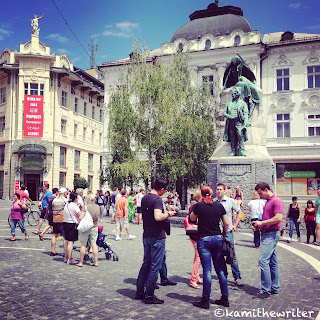 |
| Ljubljana. July 2014. |
It’s been three-fourths of a year since that road
trip through the Balkans last summer that I promised to write about more
here. I must apologize for the whole not-keeping-my-promises thing. I suppose
you’re hugely disappointed and have had to seek counseling to overcome your
rage. So sorry. ;-)
Anyway, I’m presently revisiting the trip for a travel story
pitch that, in the way of publishing’s slow-turning wheels, has finally been
picked up, which means I’m plumbing my memory, my journal, and my notes for all
the details I can get my fingertips on from that trip.
Here are a few overview thoughts that won’t make it into the
article. These are the outtakes, I suppose. But brilliant outtakes they are, so
read with attention, please. ;-)
To recap: I went on a little 12-day road trip with my friend
Olivier to visit some other friends. We started out in Aix-en-Provence, France,
drove across Italy, and slept our first night in the Balkans in Ljubljana,
Slovenia (though apparently some scholars don’t agree over whether Slovenia is officially Balkan…if I’d known this
ahead of time, I would have polled the Slovenians I met ;-) ). From there we
traveled south, eventually traversing Croatia, Bosnia-Herzegovina, Montenegro,
and northern Albania, before driving through all those countries again on the
return trip.
Similarities
Of course, one road trip does not Balkans experts make us,
but the choice to descend the peninsula by road gave us a chance to observe a
little the ways these countries aren’t all the same as well as how they do fit
together with some regional commonalities.
For starters, a somehow-comfortable melancholy seemed to
pervade the landscape all along our route. Melancholy can be soft or harsh, and
this version seemed to veer toward soft, honest.
A lingual current also ran south with us. Though the
languages are different, key words for tourists were similar—the restaurans, the stari mosts, and more.
To Each His Own
But each country also seemed to have its own personality—one
it would have been nice to mine more deeply:
Slovenia seemed lively yet calm, two adjectives that
admittedly don’t seem to go together, yet they meet in Ljubljana, Slovenia’s
capital. This country has seen less war than Croatia and Bosnia, and one can sense
this.
Croatia is absolutely beautiful yet feels already
discovered. It didn’t feel so off-the-beaten path as the other places we
visited. Like Slovenia, it’s already a member of the EU, though it’s not yet in
the eurozone while Slovenia is. And tourism is already a big deal in Croatia,
which has a good reputation for knowing how to showcase its part of the
region’s treasure collection. Overdone tourism can make a place seem stripped
of personality. But we also didn’t have any local guides in Croatia, so it’s
possible we just missed the good parts.
Bosnia felt potentially dangerous, courtesy of its recent
past, without actually being dangerous at all. Thus, it felt like a place
not-yet-fully discovered. Tourism hasn’t been overdone here yet (YET!), while at
the same time, there are growing resources for tourists.
Montenegro was just green and beautiful. We didn’t stop off
in any large cities, so our route through Montenegro’s mountains gave the
impression of a country of tucked-away hamlets that keep to themselves but are
welcoming when you enter them.
And Albania felt like a place wrestling more than all the
others with its past and its present. It’s in that awkward adolescent stage.
Where Bosnia appears to have chosen a direction, Albania is still working to
fully aim itself, but this is part of its charm for those travelers who enjoy
discovery and a little dirt mixed in with glitz, antiquated farm implements and
the occasional donkey mixed in with modern multi-story homes and lots of
new-looking cars. Tirana, Albania’s capital, is a happening place, with plenty
of nightlife, a place definitely in transition.
For the
super-motivated and curious, here’s a link to a very helpful overview of the region’s
complicated (for us outsiders anyway) recent history: “Understanding
Yugoslavia.”
No comments:
Post a Comment